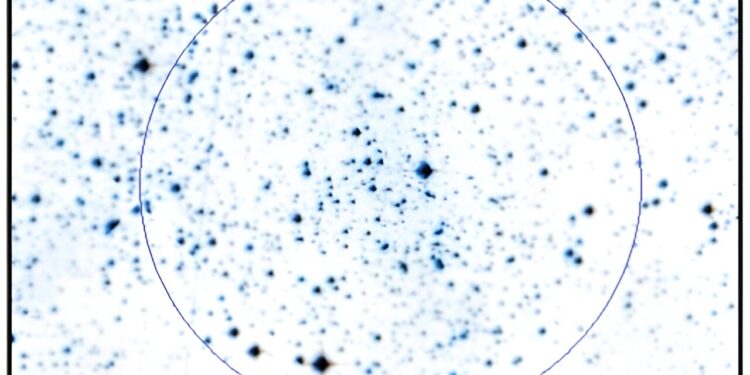Image of Ash-1 obtained at the DSS2 colour optical wavelength in the ALADIN sky atlas. Credit: Tadross et al., 2024.
Thanks to ESA’s Gaia satellite, astronomers have accidentally discovered a new open cluster in the Milky Way. The new cluster, called Ash-1, is relatively young and contains at least 400 stars. The discovery was reported in a research paper published on 21 August on the preprint server arXiv.
Open clusters (AOs), formed from the same giant molecular cloud, are groups of stars that are loosely bound to each other by gravitation. So far, more than 1,000 of them have been discovered in the Milky Way, and scientists are still searching for more, hoping to find a variety of these stellar groupings.
Expanding the list of known open galaxy clusters and studying them in detail could be crucial to improving our understanding of the formation and evolution of our galaxy.
A team of astronomers led by Ashraf Latif Tadross of the National Research Institute for Astronomy and Geophysics in Cairo, Egypt, recently announced the detection of a new open galaxy cluster. They detected the new open cluster in the constellation Sagittarius, in the field of the little-studied cluster Majaess 190.
“While examining the area surrounding the open star cluster Majaess 190, we discovered another cluster entirely by chance. It exists in a denser star field than Majaess 190, so it was difficult to recognize it from the background field,” the researchers explained.
The name of the newly discovered cluster is taken from the first three letters of the team leader’s first name: Ash-1. The data collected indicate that Ash-1 is a dynamically relaxed cluster located about 4,400 light-years from Earth.
According to the study, Ash-1 has a limiting radius of about 28.7 light-years and its total mass is 455 solar masses. The age of the cluster is estimated at 630 million years, while its relaxation time is estimated at about 25 million years. Astronomers managed to identify 410 stars that could be part of this cluster.
Based on the obtained data, the authors of the study were also able to determine the fundamental parameters of the neighboring cluster Majaess 190, finding that it is smaller, less massive, but much older than Ash-1. The limiting radius of Majaess was measured at about 12 light-years, while its total mass was calculated at 375 solar masses. The age of this cluster was estimated at about 4 billion years.
Summarizing the results, the researchers noted that Ash-1 and Majaess 190 could form a binary system. However, further observations of these clusters are needed to confirm this hypothesis.
“We believe that the two clusters are different and overlap somewhat because they form a binary system, which requires further detailed study,” the scientists conclude.
More information:
AL Tadross, has discovered a new open cluster near the little-studied Majaess 190, arXiv (2024). DOI: 10.48550/arxiv.2408.11383
Journal information:
arXiv
© 2024 Science X Network
Quote: Astronomers Discover New Open Cluster with Gaia (2024, August 27) retrieved August 27, 2024 from
This document is subject to copyright. Apart from any fair dealing for the purpose of private study or research, no part may be reproduced without written permission. The content is provided for informational purposes only.



